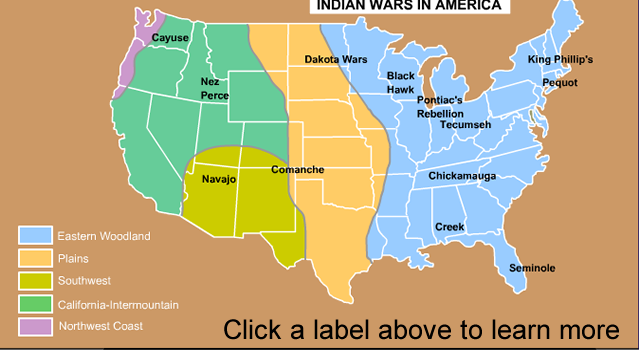What was Pontiac's Rebellion About?
Pontiac's Rebellion was a war waged by Indians of the Great Lakes region against British rule after the French and Indian War. The Indians, who had formed alliances with the defeated French, were dissatisfied with treatment from British officials. Unlike their French allies, British officials entrusted with Indian relations refused to offer gifts to tribal leaders such as guns, gunpowder, and ammunition. Furthermore, English settlers began displacing Indians from their land. While French settlers and Indians seemed to live in relative harmony, the sheer number of English settlers that descended on the region prompted many Indians to support war. The Indians began to feel as if the British were preparing for war against them. The rebellion lasted three years, from 1763 to 1766. Much of the war's terrible violence occurred in 1763; the remaining years were spent formulating peace treaties. The war was named after Pontiac, chief of the Ottawa tribe. Indians from many tribes including the Ottawa, Ojibwa, Shawnee, Miami, Huron, Seneca and Potawatomi participated in the uprising.
Massacres on Both Sides
The war started in May of 1763 when American Indians unsuccessfully besieged Fort Detroit. British reinforcements soon arrived, but were soundly defeated at the Battle of Bloody Run on July 31, 1763. Meanwhile, other Indian groups were taking forts in present-day Illinois, Michigan, Indiana, Ohio, and Pennsylvania. Many attacks followed the same routine: Indians would trick the settlers into allowing them access to the forts, and then capture or kill the inhabitants. On June 22, 1763, a group of Delaware Indians attacked Fort Pitt and killed dozens of British settlers. On September 14, 1763, a group of 300 Seneca, Ojibwa, and Ottawa Indians attacked a supply train near Fort Niagara. In what came to be known as "Devil's Hole Massacre," 72 soldiers were killed. In present-day Franklin County, Pennsylvania, four Delaware Indian warriors killed a school teacher and her ten students. Indian raids throughout Ohio Country began to intensify, as did raids conducted by local militias on peaceful Indian tribes. One local militia group, known as The Paxton Boys, traversed the Pennsylvania countryside in 1763 and 1764 searching for Indians to kill.
Both Sides Agree to End Hostilities
Soon, British officials realized that a more diplomatic solution could expedite the ending of the war. Many Indian leaders, who realized the British were not going away, and whose people were decimated with diseases such as Smallpox, were also in favor of ending the conflict. Through a combination of diplomatic and military solutions, aimed at the reclamation of Forts Niagara, Pitt, at Detroit, the British finally succeeded in ending the conflict. On July 25, 1766, a peace treaty was signed by Pontiac himself. It is important to note that the treaty was not an Indian surrender, as no prisoners were exchanged, and no land was ceded.
Click on the text in the map to learn about each of the U.S. Government-Indian Wars. |

|